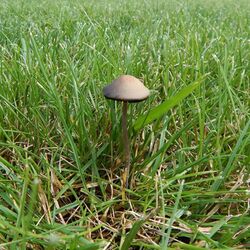Biology:Panaeolus fimicola
From HandWiki
| Panaeolus fimicola | |
|---|---|

| |
| Scientific classification | |
| Domain: | Eukaryota |
| Kingdom: | Fungi |
| Division: | Basidiomycota |
| Class: | Agaricomycetes |
| Order: | Agaricales |
| Family: | Bolbitiaceae |
| Genus: | Panaeolus |
| Species: | P. fimicola
|
| Binomial name | |
| Panaeolus fimicola (Fr.) Quél. (1872)
| |
| Synonyms[1][2][3][4] | |
| |
| Panaeolus fimicola | |
|---|---|
| Mycological characteristics | |
| gills on hymenium | |
| cap is convex | |
| hymenium is adnexed | |
| stipe is bare | |
| spore print is black | |
| ecology is saprotrophic | |
| edibility: psychoactive | |
Panaeolus fimicola is a widespread but seldom identified "little brown mushroom" which sometimes contains small amounts of the hallucinogen psilocybin. Panaeolus ater is a synonym.[1] The species is also referred to as the "turf mottlegill".[5]
Description
- Cap: (1)1.5— 3.5(4) cm, Campanulate then convex to plane, obtuse, dingy gray to blackish, often with reddish or hazel tones, hygrophanous, pallid grey to yellowish when dry, smooth, with a narrow brown marginal band, slightly striate at the margin when moist. Flesh thin and grayish.
- Gills: Adnate, close to crowded, at first gray-olivacous, becoming mottled and darkening to black with age, edges remaining whitish.
- Spores: Blackish gray.
- Stipe: (4)6 — 8(10) cm x 1 — 2(3) mm, equal, slender, slightly enlarging at the base, hollow, fragile, dingy white to clay, becoming brownish towards the base in age, smooth, white-pruinose at the apex, obsoletely slightly silky-striate, ring absent. Flesh is dirty ochraceous-buff; fragile.
- Taste: Not distinctive.
- Odor: Not distinctive.
- Microscopic features: Spores 10.8 — 14.2 X 6.9—9.5, ellipsoid or lemon shaped, basidia 4 spored. Gill edge cystidia fusiform, typically with long necks, gill face cystidia absent.
Habitat and formation
Panaeolus fimicola can be found growing solitary to scattered in soil or dung, fertilized lawns and other grassy places, late spring to mid-fall. It is widespread and common across the Americas, as well as Europe and Africa. It has also been found in Turkey.[6] Panaeolus Fimicola will often appear during or after a cold rain.
See also
References
- ↑ 1.0 1.1 Gerhardt, E. (1996). "Taxonomische Revision der Gattungen Panaeolus und Panaeolina (Fungi, Agaricales, Coprinaceae)". Bibliotheca Botanica 147: 1–149.
- ↑ "Panaeolus ater (J.E. Lange) Kühner & Romagn. (1953)". MycoBank. International Mycological Association. http://www.mycobank.org/BioloMICS.aspx?Table=Mycobank&Rec=535810&Fields=All.
- ↑ "Panaeolus fimicola (Fr.) Quél. (1872)". MycoBank. International Mycological Association. http://www.mycobank.org/Biolomics.aspx?Table=Mycobank&MycoBankNr_=158646.
- ↑ "Panaeolus fimicola var. ater J.E. Lange (1940)". MycoBank. International Mycological Association. http://www.mycobank.org/BioloMICS.aspx?Link=T&TableKey=14682616000000067&Rec=187526&Fields=All.
- ↑ "Panaeolus fimicola, Turf Mottlegill, identification". https://www.first-nature.com/fungi/panaeolus-fimicola.php.
- ↑ Kaya, Abdullah (2015). "Contributions to the macrofungal diversity of Atatürk Dam Lake basin". Turkish Journal of Botany 39: 162–172. doi:10.3906/bot-1404-70. http://journals.tubitak.gov.tr/botany/issues/bot-15-39-1/bot-39-1-16-1404-70.pdf.
- Stamets, Paul (1996). Psilocybin Mushrooms of the World. Berkeley: Ten Speed Press. ISBN 0-9610798-0-0.
External links
Wikidata ☰ Q4405497 entry
 |

